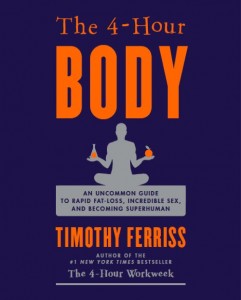 Four hours a month to achieve your desired body — that’s what Tim Ferriss claims in his international best-seller, The Four Hour Body. As a fitness coach, people often ask me about that book: “Is it possible? “Is it just a bunch of bull?” “Can you really only spend four hours a month and achieve an awesome body?”
Four hours a month to achieve your desired body — that’s what Tim Ferriss claims in his international best-seller, The Four Hour Body. As a fitness coach, people often ask me about that book: “Is it possible? “Is it just a bunch of bull?” “Can you really only spend four hours a month and achieve an awesome body?”
Why not?
Now, I must say, I didn’t read his book. (I loved the 4-Hour Work Week, though.) But when you think about it, it’s very possible, and – more importantly – I think it’s crucial for people to start thinking, “Well, if I can only work out for 4 hours per month, what the hell should I do?!” And that’s where we’ll start.
Let’s say someone put a gun to your head (or whatever torture device you can think of — a Justin Beiber album on repeat, for example) and says, “you have to get a good body with only four hours a MONTH of training.” After you stop crying and clean yourself up, start planning your workouts.
4 hours a month. That’s 1 hour a week. How many workouts should you do? 1, 2, or 3? 3 is tough because it leaves only 20 minutes per workout. A good warmup could take 8-10 minutes because we don’t want to hurt ourselves, so that leaves too little time to train. 1 workout a week isn’t enough because it won’t elicit enough body adaptations. (This is hard to explain, but trust me — I’m a nerd.) Okay, let’s go with 2 per week for 30 minutes. Now, the next question, “What will we do?”
 I can tell you, if you only have less-than-30 minutes to train (because of a warmup), you better throw bicep curls and tricep kickbacks in the trash. Those exercise are so small and ineffective, it would be a waste of your precious time. So would the treadmill, elliptical, and stationary bike. We’re trying to change your body right? We need to lift weight to burn calories, melt fat, and spark muscle growth at the same time.
I can tell you, if you only have less-than-30 minutes to train (because of a warmup), you better throw bicep curls and tricep kickbacks in the trash. Those exercise are so small and ineffective, it would be a waste of your precious time. So would the treadmill, elliptical, and stationary bike. We’re trying to change your body right? We need to lift weight to burn calories, melt fat, and spark muscle growth at the same time.
Gray Cook, MSPT, OCS, CSCS, RKC refers to this as “exercise economy.” If I asked you what the single best exercise was, different people may come up with different answers: the squat, the deadlift, the Turkish get-up, the kettlebell swing, etc. The idea is, there is no “best exercise” — there is, however, an importance of prioritizing these lifts in your workout. And the unifying features of those examples are that they all are multi-joint, complex exercises that hit major muscle groups.
Now let’s assume an 8 minute dynamic warmup. That leaves 22 minutes to train. We need to save time, so doing 20 reps of something is wayyy to much — let’s keep it between 5 and 8. Thus every set will take somewhere around 30 seconds (a very rough estimation). Wow, all of a sudden that doesn’t seem so much:
- Some type of heavy squat/deadlift for 6 reps: 30s of work
- Rest for 1 minute.
- Some type of heavy row for 6 reps: 30s of work
- Rest for 1 minute.
- Some type of heavy push for 6 reps: 30s of work
- Rest for 1 minute.
That’s 4 minutes and 30 seconds for a circuit. Not bad. You can do something like 4 sets of those and be done in under 22 minutes. (You may even have time left over.) Then you can pick different exercises in your second workout of the week for the same time. As long as you keep increasing weight from workout-to-workout, you’ll get stronger, build more muscle, and burn more calories.
Want more numbers? Let’s say you only squat twice a week and increase it by only 5lbs every workout. In 6 months, that’s 240lb of added weight. How different do you think you’ll look if you can squat 6 reps of 285lb (that includes the barbell) compared to whatever you started with?
Extremely different.
Take the Chili’s approach to training and thrive: “Get in. Get out. Get on with your life.”
Leave a Reply